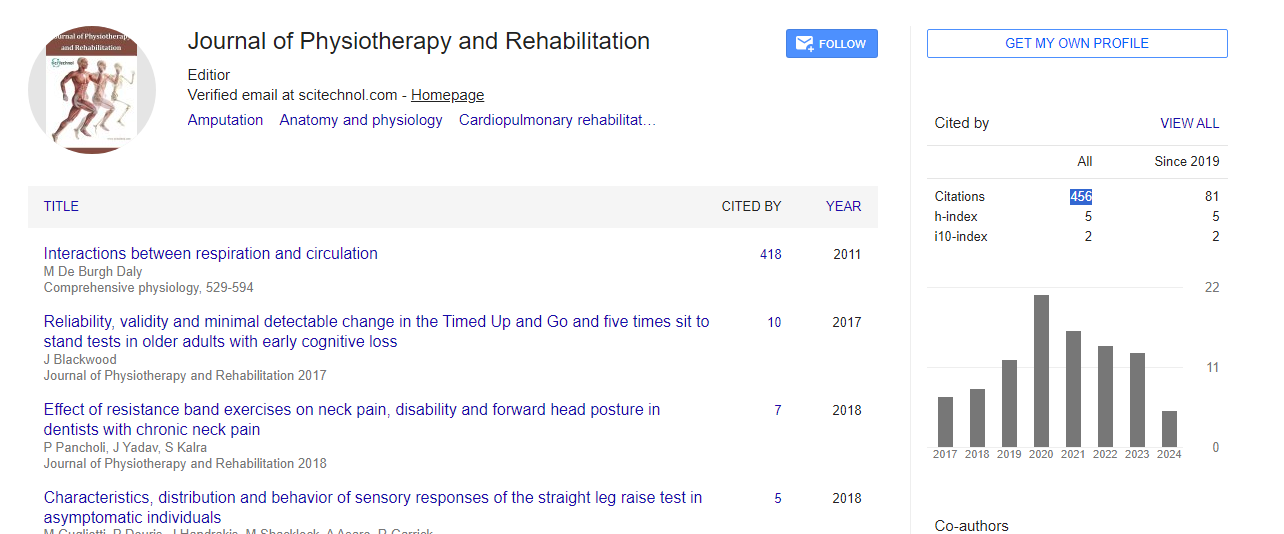Opinion Article, J Physiother Rehabi Vol: 8 Issue: 6
Role of Kinesiology in Enhancing Performance and Reducing Injury Risk Among Professional Dancers and Performing Artists
Vagedes Granero*
1Department of Physiotherapy, University of Freiburg, Fahnenbergplatz, Germany
*Corresponding Author: Vagedes Granero,
Department of Physiotherapy,
University of Freiburg, Fahnenbergplatz, Germany
E-mail: granerovag@des.de
Received date: 23 November, 2024, Manuscript No. JPTR-24-155487;
Editor assigned date: 25 November, 2024, PreQC No. JPTR-24-155487 (PQ);
Reviewed date: 09 December, 2024, QC No. JPTR-24-155487;
Revised date: 17 December, 2024, Manuscript No. JPTR-24-155487 (R);
Published date: 24 December, 2024, DOI: 10.4172/JPTR.1000198.
Citation: Granero V (2024) Role of Kinesiology in Enhancing Performance and Reducing Injury Risk among Professional Dancers and Performing Artists.
J Physiother Rehabi 8:6.
Description
Kinesiology plays an essential role in enhancing the performance and reducing the injury risk of professional dancers and performing artists. These individuals depend on heavily on their bodies to perform complex and physically demanding movements, making them subjected to musculoskeletal injuries and physical strain. Kinesiology, the study of human movement, biomechanics and exercise physiology, provides valuable introduction and techniques that can improve performance, prevent injuries and promote long-term physical happiness for dancers and other performing artists.
One of the primary contributions of kinesiology to the performing arts is its ability to improve movement efficiency. Dancers, musicians and actors often perform repetitive motions that can lead to muscle imbalances, joint stress and fatigue. Kinesiologists assess these movement patterns to identify areas where inefficiencies may occur, such as improper posture or misalignment. By applying principles of biomechanics and muscle activation, kinesiologists help performing artists optimize their movements, ensuring that energy is used effectively and reducing the unnecessary strain on muscles and joints. Efficient movement not only enhances performance but also reduces the risk of overuse injuries and improves stamina during prolonged performances or rehearsals. In addition to improving performance, kinesiology focuses on injury prevention. Professional dancers and performing artists are at high risk for acute injuries, such as sprains, strains and fractures, as well as chronic injuries, including tendonitis, stress fractures and joint degeneration.
Kinesiologists plays a key role in preventing these injuries by identifying risk factors related to posture, flexibility, strength and body alignment. For instance, poor flexibility or muscle tightness can lead to an increased risk of strain or tear. Kinesiologists design customized stretching and flexibility programs to address these issues, ensuring that performing artists maintain an optimal range of motion and avoid overstretching or damaging tissues. Strengthening exercises are another important aspect of kinesiology in injury prevention. Muscular weakness can make certain areas of the body more susceptible to injury. Kinesiologists work with dancers and performing artists to develop individualized strength training programs that target key muscle groups. These exercises often focus on core strength, which is essential for maintaining proper posture and balance, as well as lower body and joint stability to support dynamic movements like jumps, leaps and pivots. Additionally, strength training helps to maintain muscle mass and endurance, reducing the fatigue that can lead to poor performance and injury.
Dancers and performing artists often perform complex, intricate movements that require precise control and coordination. Poor balance or a lack of proprioception can lead to missteps, falls or overstretching. Kinesiologists use various balance and coordination exercises, such as standing on unstable surfaces or engaging in dynamic movements, to improve proprioception and neuromuscular control. These exercises not only help prevent falls but also contribute to smoother, more controlled movements during performances. Moreover, kinesiology aids in the recovery and rehabilitation of injuries when they occur. Despite the best efforts to prevent them, injuries are a reality for many professional dancers and performing artists. Kinesiologists assist in the rehabilitation process by using targeted exercises and techniques that promote tissue healing, restore movement patterns and rebuild strength. Rehabilitation programs often include modalities such as ice and heat therapy, massage and joint mobilizations to reduce inflammation and pain. Kinesiologists also focus on gradual reloading of injured areas, helping dancers and performers safely return to their routines without risking further injury.
Conclusion
Kinesiology plays an essential role in enhancing performance and reducing injury risk among professional dancers and performing artists. By optimizing movement efficiency, preventing injuries and aiding in rehabilitation, kinesiologists help performers maintain peak physical condition throughout their careers. The combination of strength, flexibility, balance and body awareness through kinesiology not only enhances the quality of a performer’s art but also supports their longterm health and comfort. In a field where physical demands are high and injuries are common, the application of kinesiology is an essential tool for preserving the body’s ability to perform at its best.
 Spanish
Spanish  Chinese
Chinese  Russian
Russian  German
German  French
French  Japanese
Japanese  Portuguese
Portuguese  Hindi
Hindi 